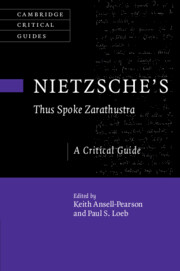127 results
Acknowledgments
-
- Book:
- Nietzsche's ‘Thus Spoke Zarathustra'
- Published online:
- 09 June 2022
- Print publication:
- 23 June 2022, pp x-x
-
- Chapter
- Export citation
Copyright page
-
- Book:
- Nietzsche's ‘Thus Spoke Zarathustra'
- Published online:
- 09 June 2022
- Print publication:
- 23 June 2022, pp iv-iv
-
- Chapter
- Export citation
Index
-
- Book:
- Nietzsche's ‘Thus Spoke Zarathustra'
- Published online:
- 09 June 2022
- Print publication:
- 23 June 2022, pp 266-277
-
- Chapter
- Export citation
Bibliography
-
- Book:
- Nietzsche's ‘Thus Spoke Zarathustra'
- Published online:
- 09 June 2022
- Print publication:
- 23 June 2022, pp 247-264
-
- Chapter
- Export citation
Note on Texts, Translations, and References
-
- Book:
- Nietzsche's ‘Thus Spoke Zarathustra'
- Published online:
- 09 June 2022
- Print publication:
- 23 June 2022, pp xi-xi
-
- Chapter
- Export citation
Chapter 2 - Philosophy As a Way of Life in Thus Spoke Zarathustra
-
-
- Book:
- Nietzsche's ‘Thus Spoke Zarathustra'
- Published online:
- 09 June 2022
- Print publication:
- 23 June 2022, pp 41-61
-
- Chapter
- Export citation
Introduction
-
-
- Book:
- Nietzsche's ‘Thus Spoke Zarathustra'
- Published online:
- 09 June 2022
- Print publication:
- 23 June 2022, pp 1-14
-
- Chapter
- Export citation
Contents
-
- Book:
- Nietzsche's ‘Thus Spoke Zarathustra'
- Published online:
- 09 June 2022
- Print publication:
- 23 June 2022, pp vii-viii
-
- Chapter
- Export citation
Epigraph
-
- Book:
- Nietzsche's ‘Thus Spoke Zarathustra'
- Published online:
- 09 June 2022
- Print publication:
- 23 June 2022, pp v-vi
-
- Chapter
- Export citation
Contributors
-
- Book:
- Nietzsche's ‘Thus Spoke Zarathustra'
- Published online:
- 09 June 2022
- Print publication:
- 23 June 2022, pp ix-ix
-
- Chapter
- Export citation
Abbreviations
-
- Book:
- Nietzsche's ‘Thus Spoke Zarathustra'
- Published online:
- 09 June 2022
- Print publication:
- 23 June 2022, pp xii-xiv
-
- Chapter
- Export citation

Nietzsche's ‘Thus Spoke Zarathustra'
- A Critical Guide
-
- Published online:
- 09 June 2022
- Print publication:
- 23 June 2022
College student sleep quality and mental and physical health are associated with food insecurity in a multi-campus study
-
- Journal:
- Public Health Nutrition / Volume 24 / Issue 13 / September 2021
- Published online by Cambridge University Press:
- 22 March 2021, pp. 4305-4312
-
- Article
-
- You have access
- Open access
- HTML
- Export citation
Correlates of a southern diet pattern in a national cohort study of blacks and whites: the REasons for Geographic And Racial Differences in Stroke (REGARDS) study
-
- Journal:
- British Journal of Nutrition / Volume 126 / Issue 12 / 28 December 2021
- Published online by Cambridge University Press:
- 26 February 2021, pp. 1904-1910
- Print publication:
- 28 December 2021
-
- Article
-
- You have access
- Open access
- HTML
- Export citation
Chapter 7 - Bergson and Philosophy as a Way of Life
-
-
- Book:
- Interpreting Bergson
- Published online:
- 22 November 2019
- Print publication:
- 12 December 2019, pp 121-138
-
- Chapter
- Export citation
Pulsar Searches with the SKA
-
- Journal:
- Proceedings of the International Astronomical Union / Volume 13 / Issue S337 / September 2017
- Published online by Cambridge University Press:
- 04 June 2018, pp. 171-174
- Print publication:
- September 2017
-
- Article
-
- You have access
- Export citation
2 - SUPPLEMENTARY MATERIAL TO ON THE GENEALOGY OF MORALITY
-
- Book:
- Nietzsche: <I>On the Genealogy of Morality</I> and Other Writings
- Published online:
- 28 May 2018
- Print publication:
- 16 January 2017, pp 125-126
-
- Chapter
- Export citation
Preface
- from 1 - ON THE GENEALOGY OF MORALITY
-
- Book:
- Nietzsche: <I>On the Genealogy of Morality</I> and Other Writings
- Published online:
- 28 May 2018
- Print publication:
- 16 January 2017, pp 3-124
-
- Chapter
- Export citation
Index of names
-
- Book:
- Nietzsche: <I>On the Genealogy of Morality</I> and Other Writings
- Published online:
- 28 May 2018
- Print publication:
- 16 January 2017, pp 185-188
-
- Chapter
- Export citation
Contents
-
- Book:
- Nietzsche: <I>On the Genealogy of Morality</I> and Other Writings
- Published online:
- 28 May 2018
- Print publication:
- 16 January 2017, pp v-v
-
- Chapter
- Export citation



